Sirius A is a binary star, and it is the brightest star in the night sky located in the Canis Majoris constellation.
Key Facts & Summary
- The name Sirius is derived from the Greek word “Seirios” meaning “glowing” or “scorching.”
- It has a visual apparent magnitude of -1.46, being twice as bright as Canopus, the second brightest star. It has an absolute visual magnitude of + 1.42, being 25 times more luminous than the Sun.
- Sirius A is about twice as massive as the Sun.
- Sirius is a binary star consisting of a main-sequence star of spectral type A0 or A1, termed Sirius A, and a faint white dwarf companion named Sirius B, which is a spectral type DA2 star.
- Since it is so bright and the nearest that can be seen without the aid of a telescope, it has been known to the ancients for a long time, dating back to even 4.000 years ago by ancient Egyptians.
- The distance between the two stars varies between 8.2 AU and 31.5 AU as they orbit every 50 years.
- The Sirius system is one of the nearest neighbors to Earth, being at a distance of 8.6 light-years / 2.64 parsecs away.
- The Sirius system is speculated to be between 200 to 300 million years old.
- In 1868, Sirius became the first star to have its velocity measured. It rotates at a speed of 16 km/s.
- Sirius B is around 100.000 times fainter than Sirius A.
- Sirius A radiates about 26 times as much energy as our Sun.
- Sirius B is the first white dwarf to be discovered, a type of star first understood by Subrahmanyan Chandrasekhar in 1930. Sirius B is also the closest white dwarf star to Earth.
- Sirius A produces energy by fusing hydrogen atoms in its core, much like our Sun.
- Sirius B is about the same size as Earth, however, it has almost the same mass as the Sun, making it an incredibly dense object.
- Temperatures on the surface of Sirius A have been estimated to be around 10.000 degrees Celsius / 18.000 degrees Fahrenheit.
- Sirius B, on the other hand, is almost five times as hot as the sun. It has surface temperatures around 25.000 degrees Celsius / 45.000 degrees Fahrenheit.
Sirius was known to the ancients due to its immense brightness, and as such, it was well represented in the mythologies of many different cultures. References to this star can be traced back even to the Neolithic period.
However, the fact that it is a binary star is a “fairly” recent discovery. It happened in 1844 with the German astronomer Friedrich Wilhelm Bessel being the first to note this.
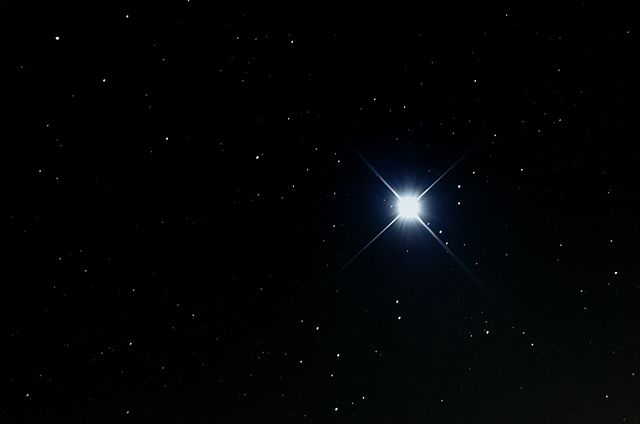
The astronomer had observed that the bright star was pursuing a slightly wavy course among its neighbors in the sky and concluded that it had a companion star, with which it revolved in a period of 50 years.
This companion, later named Sirius B, was first seen in 1862 by Alvan Clark, an American astronomer, and telescope maker.
Location
Sirius is located in the Canis Majoris constellation being the chief star in the constellation.
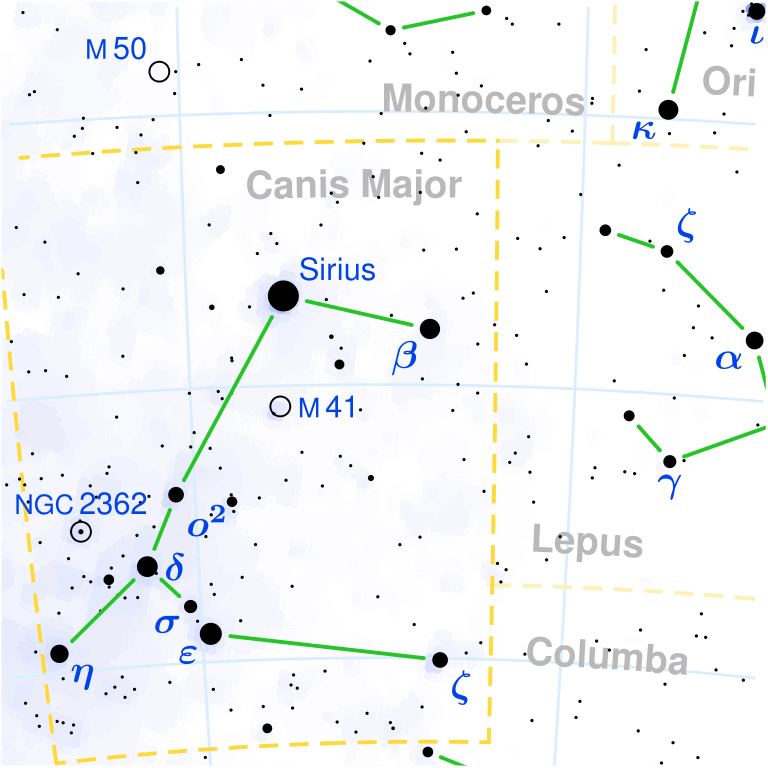
It can be easily be located by using Orion’s belt.
Distance, Size - Mass
Sirius is about 8.611 light-years away from Earth, or 81.46 trillion km / 50.61 mi. It is the fifth closest star system to us and contains two of the eight nearest stars to Earth.
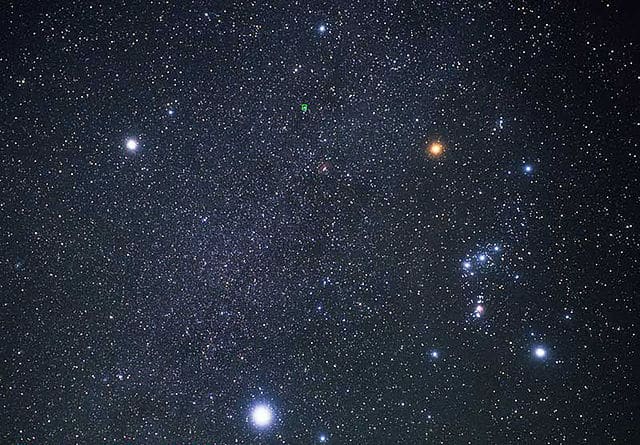
Sirius A has a radius of about 740.000 mi / 1.2 million km, being 71% larger than the radius of the Sun. Sirius B has a radius around 3.650 mi / 5.900 km, thus being slightly smaller than Earth.
Sirius A has a diameter of about 1.5 million mi / 2.4 million km, almost 171% of the Sun’s diameter. Sirius B, on the other hand, has a diameter of 7.300 mi / 11.800 km, approximatively 92% of Earth’s diameter.
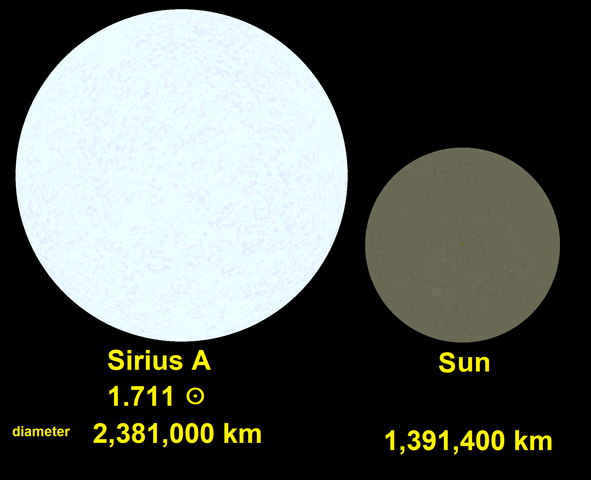
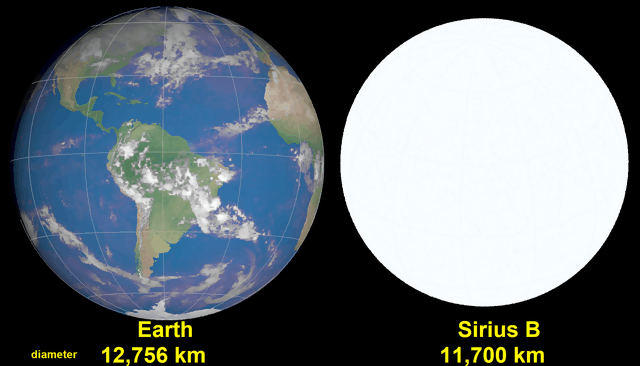
Sirius A is about 25 times brighter than our Sun, while Sirius B is only 3% as bright as the sun. The mass of Sirius A is 2.02 that of the Sun while Sirius B has about 0.98. Though since Sirius B is about the size of Earth, its mass in relation to this is quite big making it very dense. Sirius B was once more massive than Sirius A.
Orbit - Rotation – Stellar System
Both stars orbit each other with a separation of about 20 AU or roughly the distance between the Sun and Uranus. The age of this system is estimated to be around 230 million years old. They have an elliptical orbit that takes 50 years to complete.
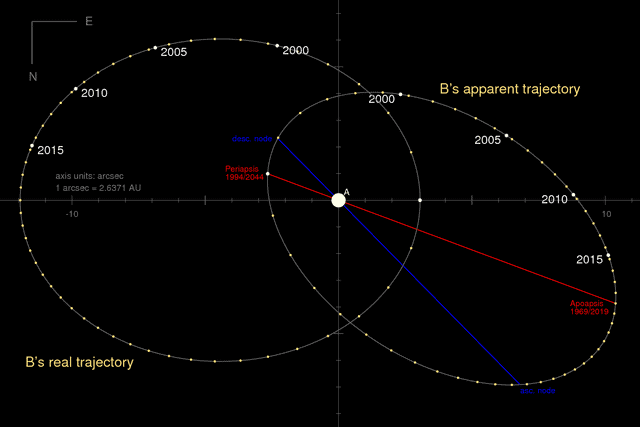
Sirius A has a projected rotational velocity of about 16 km/s. This doesn’t produce any significant flattening of the disk. A very weak magnetic field has been detected on the surface of Sirius A.
Formation - Composition
It is theorized that Sirius A formed during the collapsing of a molecular cloud. After 10 million years the internal energy generation was derived entirely from nuclear reactions. Meaning, the core became convective and used the CNO cycle for energy generation.
Sirius B passed through a red giant stage. This occurred when it had less than half its current age, around 120 million years ago. While it passed through this stage, the star may have enriched the metallicity of its companion.
Sirius B is primarily made out of a carbon-oxygen mixture that was generated by helium fusion in the progenitor star. The outer atmosphere is now almost pure hydrogen, the element with the lowest mass.
Future
It is predicted that Sirius A will completely exhaust its store of hydrogen at its core within a billion years from its formation. It will pass through a red giant stage, then settle down to become a white dwarf similarly to Sirius B.
Sirius B has no internal heating source and will eventually cool as the remaining heat is radiated into space over more than two million years.
Did you know?
- Sirius is gradually moving closer to the Solar System. Because of this, its brightness will increase over the next 60.000 years and after this, its distance will begin to increase becoming fainter though it will continue to be the brightest star in the Earth’s night sky for the next 210.000 years
- Sirius has a significantly lower luminosity than other bright stars such as Canopus or Rigel, but due to its closeness to us, it appears brighter.
- The Sirius system was originally made up of two bluish stars but the more massive one, Sirius B, consumed its resources and became a red giant before shedding its outer layers and collapsing into its current state as a white dwarf around 120 million years ago.
- Sirius is known colloquially as the “Dog Star”, reflecting its prominence in its constellation Canis Major – Greater Dog. The rising of Sirius marked the flooding of the Nile in Ancient Egypt.
- The rising of Sirius marked the “dog days” – hot days – of summer for the ancient Greeks.
- For the Polynesians, mostly in the Southern Hemisphere, the rising star marked the coming of winter and it was an important reference for their navigation around the Pacific Ocean.
- There are conflicting pieces of evidence that suggest Sirius appeared redder only 2.000 years ago.
- Sirius has over 50 designations and names attached to it.
- Around the year 9.000, Sirius will no longer be visible from northern and central Europe.
- Sirius often flickers with many colors thus prompting people to report it as a UFO.
- It is speculated that the character Sirius, in the Harry Potter series, who has a unique ability to transform into a black dog, might have been inspired by “Sirius B.”
- The Dogon people of Mali in Africa knew about the second star in the Sirius system long before it was discovered. They portrayed both stars at the center of their religion. They even knew the actual orbital period of the stars. How could they have known this remains a mystery.
Sources:
Image source:
- https://upload.wikimedia.org/wikipedia/commons/thumb/c/c6/Sirius.jpg/640px-Sirius.jpg
- https://upload.wikimedia.org/wikipedia/commons/thumb/a/af/Canis_Major_constellation_map.svg/768px-Canis_Major_constellation_map.svg.png
- https://upload.wikimedia.org/wikipedia/commons/thumb/b/b1/Hubble_heic0206j.jpg/640px-Hubble_heic0206j.jpg
- https://upload.wikimedia.org/wikipedia/commons/thumb/5/5f/Sirius_A-Sun_comparison2.png/591px-Sirius_A-Sun_comparison2.png
- https://upload.wikimedia.org/wikipedia/commons/thumb/d/dd/Sirius_B-Earth_comparison2.png/640px-Sirius_B-Earth_comparison2.png[6.] https://upload.wikimedia.org/wikipedia/commons/thumb/5/5d/Orbit_Sirius_B_arcsec.png/640px-Orbit_Sirius_B_arcsec.png
